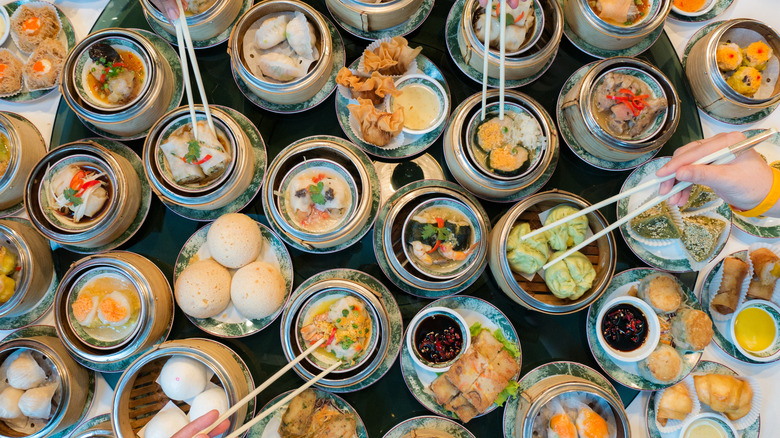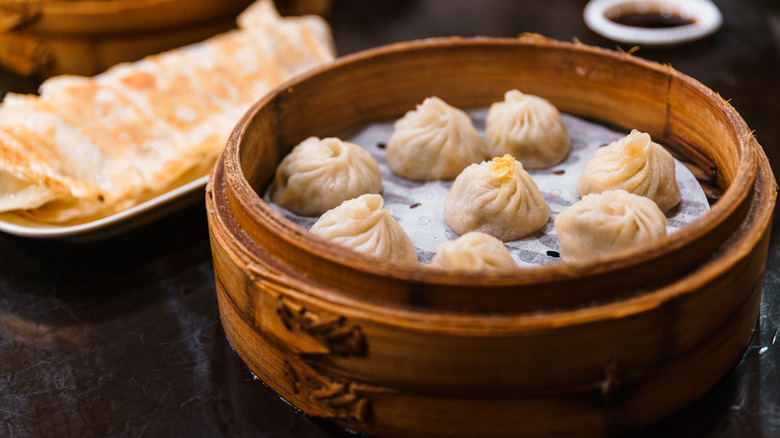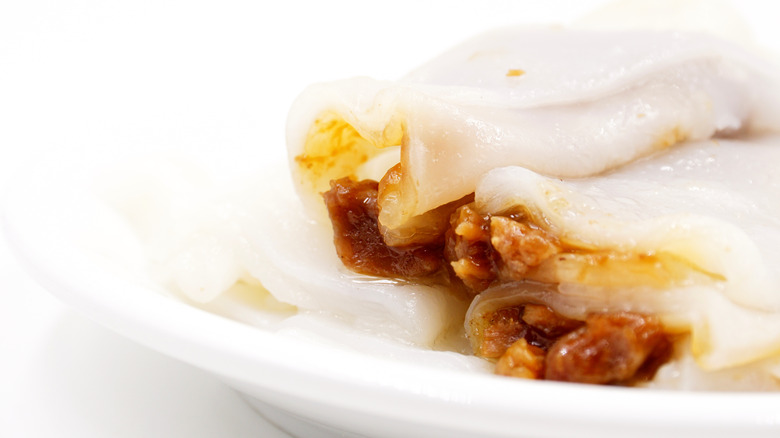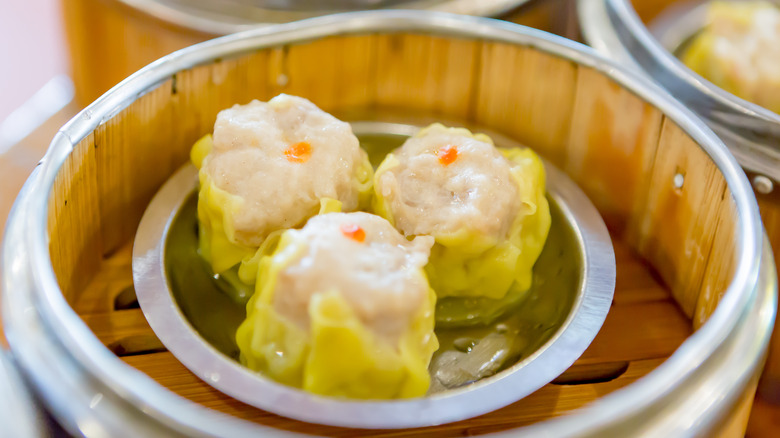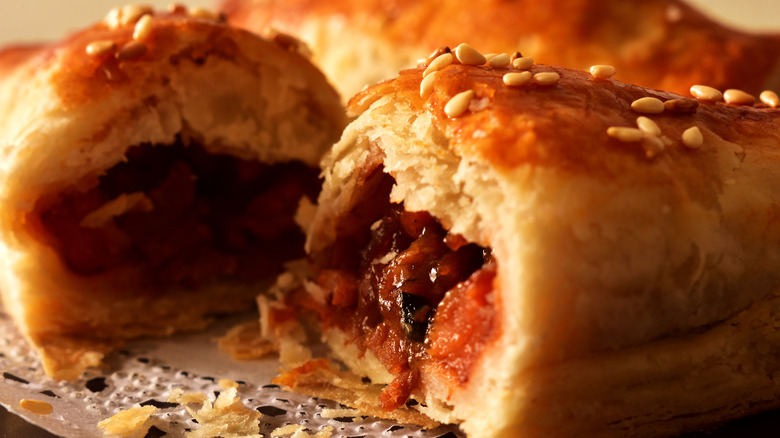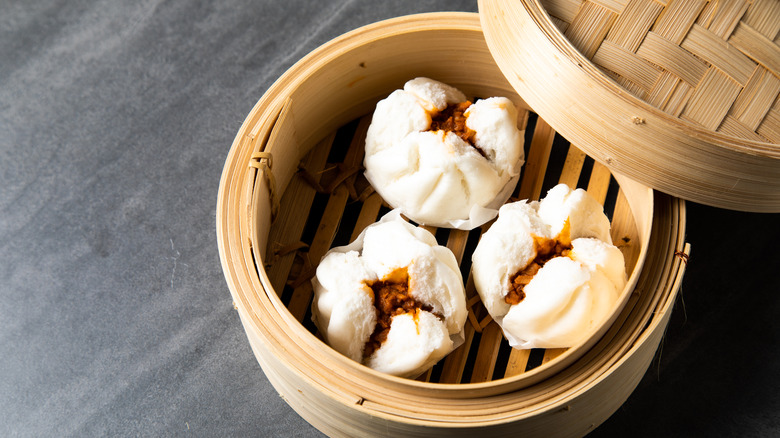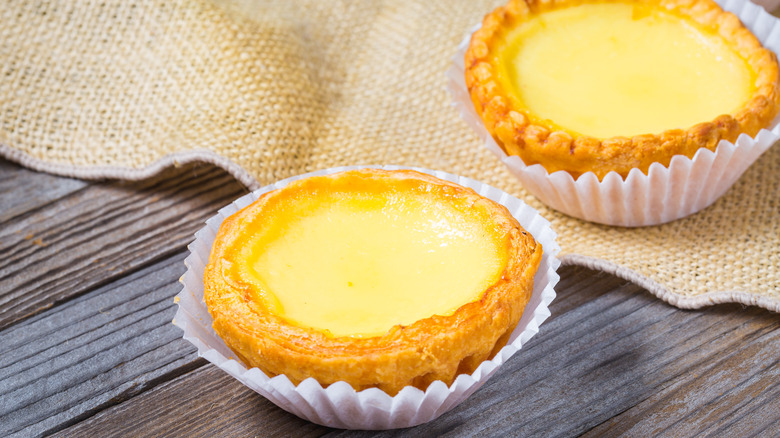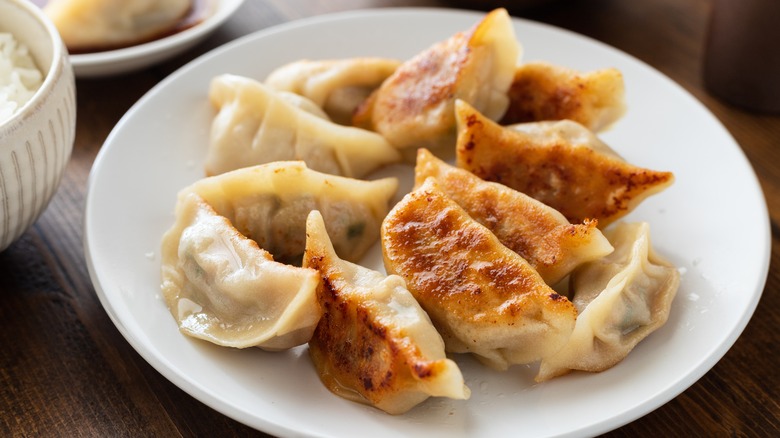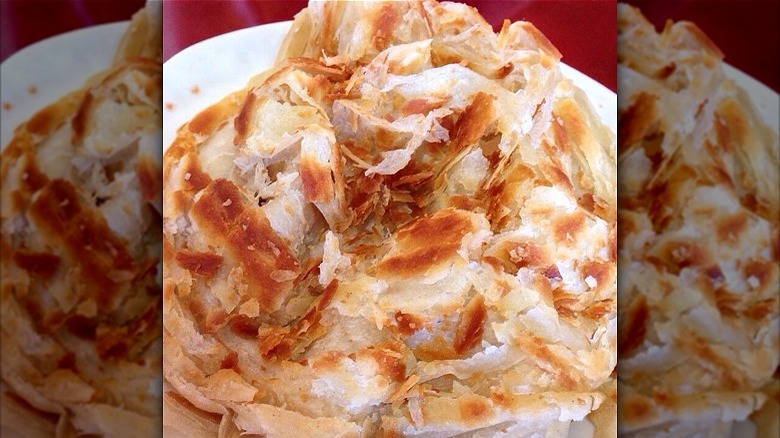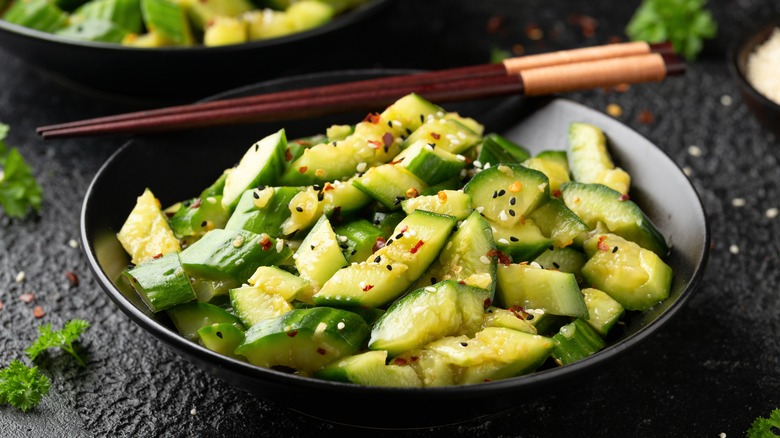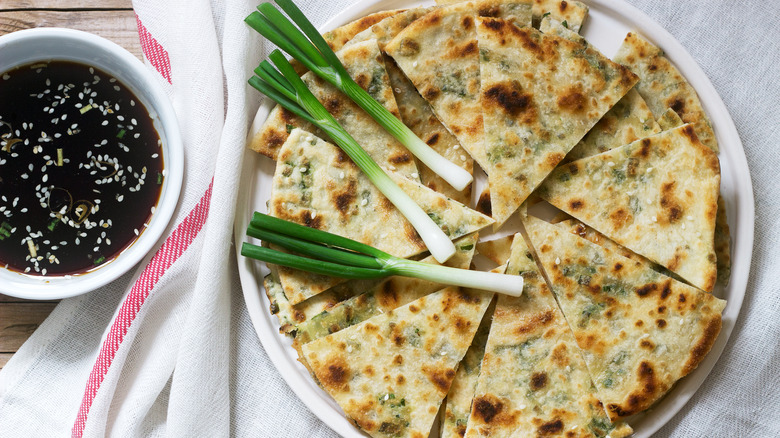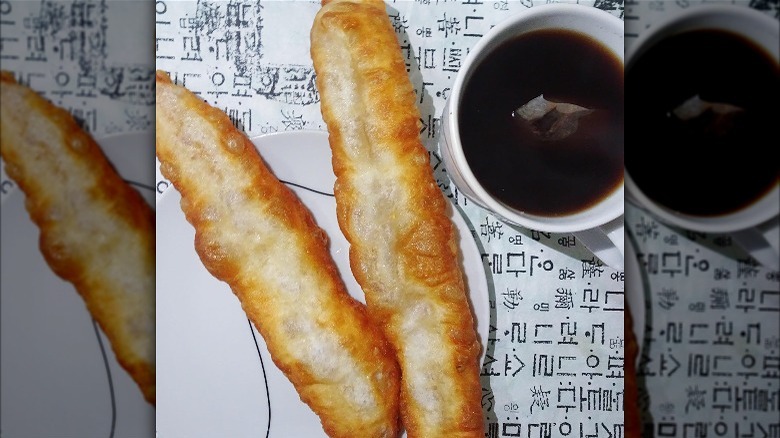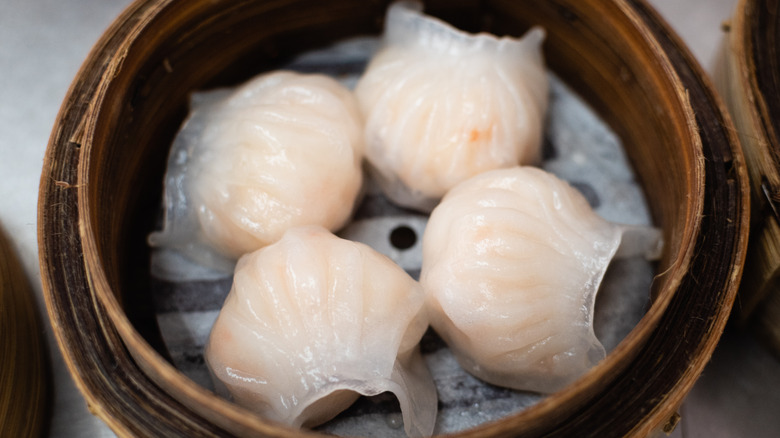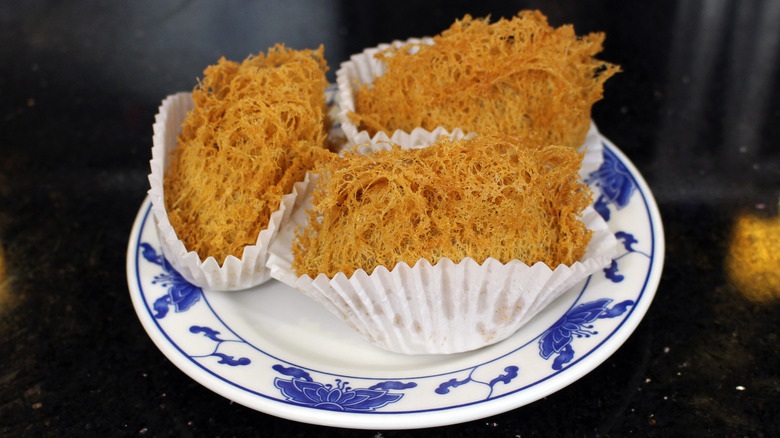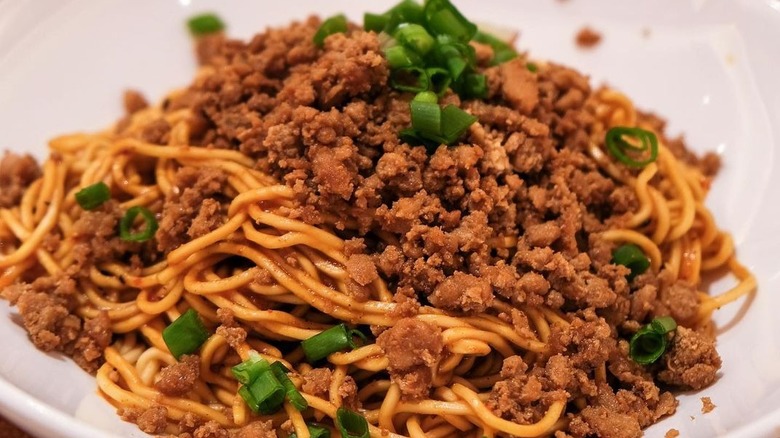14 Dim Sum Plates You Need To Try
Plans before and after dim sum do not exist. On dim sum's chosen day (often Saturday or Sunday), every move revolves around the main event of roaming carts and steamed dumplings. The preparation is ritualistic and departure times are planned the night before with the only objective of avoiding the inevitable crowds. The morning of, a consensus to forgo breakfast to save stomach space overrides all other discussions — besides talking about the food options of course. Will the char siu bao be available? What should we special-order? Before long, everyone is gathered around the table, holding porcelain cups of hot tea and flagging down every cart that drives by.
Per Asia Society, dim sum comes from China's Guangdong region, where small plates and shared dining first took off. Before long, it made its way to Hong Kong to secure its rightful throne among Chinese culinary traditions, and eventually, dim sum's charm spread worldwide. Next time you find yourself with the opportunity to enjoy this decadent meal, make sure to add these dim sum plates to the adventure.
Xiaolongbao
Soup dumplings had a flashy introduction to America's dumpling repertoire when The Drunken Dumpling in NYC ditched tradition for a soup dumpling large enough to fill an entire bamboo steamer (via Eater). Since then, the fascination with the juicy dumplings has spread throughout the country.
Modern Shanghainese xiaolongbao —or little basket buns (via Food Lover's Guide to the World) — originated in Changzhou in China's Jiangsu Province (via Shine). American soup dumpling impressions are fairly limited, as there are in fact many kinds of xiaolongbao with varying characteristics. For example, soup dumplings from Changzhou are fresh, Wuxi-style are sweet, and Shanghai soup dumplings are a combination of flavors in every umami bite. Meanwhile, a new and smaller xiaolongbao from the Shanghai suburb of Nanxiang has taken the city by storm.
Regardless of the type, these dumplings are always steamed in stacked baskets. The carefully pleated wrapper is paper thin and the slightest touch causes the dumpling to jiggle. The explosively juicy interior is traditionally made with ground pork, seasonings, and a gelatinous broth that becomes liquid when steamed.
Once the steamers hit the table alongside bowls of ginger-infused vinegar, everyone assesses the eating situation individually. Stick the whole dumpling in your mouth, exposing your palate to scalding juices? Or, cautiously attempt a smaller bite and risk a little soup leakage, in which case, a spoon is nothing short of essential.
Cheung Fun
Steaming containers of pearly white rice are synonymous with American Chinese takeout culture; an irreplaceable meal component to soak up the saucy goodness that coats pieces of chicken or tender beef strips. But rice can come in many forms, and in South China rice noodles are abundant. Rice cake disks soak up thick sauces, wide noodles float in spicy broths, and sheets of flat ho fun envelop pieces of succulent meat — a perfect transition to the greatness that is cheung fun.
There are two different styles of cheung fun: Penang and Cantonese. Penang cheung fun features a thick shrimp paste (hae ko) inside a ho fun noodle flavored with a sweet soy sauce (via Yahoo News). On the other hand, the original Cantonese version (kong sik chee cheong fun) often includes delicately cooked whole shrimp or pieces of pork or beef. The noodles are made from rice flour and other starches and must be made shortly before eating (via The Guardian). At dim sum parlors, you'll often find cheung fun based on the Hong Kong tradition, with pale pink shrimp peaking through translucent sheets of rice noodles.
Siu mai
Steamer baskets carry the mother load when it comes to dim sum brunch. But siu mai has an aura that cannot be put into words. The open-topped dumplings filled with a pork and shrimp paste wrapped in a pleasantly wrinkled wrapper look right at home tucked inside the iconic metal steamers. The hype is certainly real. Proud enthusiasts congregate online via the "Hong Kong Siu Mai Concern Group," a page dedicated to scouting out the best siu mai in Hong Kong (via Hong Kong Free Press).
Siu mai is a born and bred Hong Kong dumpling treasure, so much so that shop owner Patrick Chu emphasizes that "Siu mai is part of Hong Kong people's lives" (via South China Morning Post). The dish's history is old and complicated, but current Hong Kong styles point to an early version coming from Hohhot, the Chinese capital of the Inner Mongolia region. No matter where it came from, siu mai is found on the streets, in dim sum parlors, and anywhere in between (including local 7-Elevens).
Chinese siu mai (different from Filipino, Indonesian, and Vietnamese versions) is made with pork, shrimp, or both, wrapped in round fragile dumpling wrappers (via Asia Society). So, whether this pillar Cantonese dumpling reaches your lips on the street or in a dim sum parlor, be ready to obsess over these exposed meat dumplings.
Char Siu Sou
Any dish that begins with flaky pastry dough and sweet sticky char siu pork undoubtedly ends with a happy stomach. Char siu sou combines both, creating a delicate savory pastry that has the potential to steal the dim sum show.
Char siu is having a moment, especially amongst American barbecue fans looking for international inspiration. Per Taste Atlas, the preparation consists of roasted barbecue pork marinated in soy sauce, hoisin sauce, rice wine, and star anise. The meat becomes highly caramelized when exposed to the fiery flames before it is chopped up to use for fashionable char siu bao, and of course, char siu sou.
Char siu sou would be nothing, however, without sou pastry. The flaky pastry is composed of two types of dough: one made with flour and water and the other mostly with pork lard (or vegetable shortening). Like puff pastry, the two doughs are laminated to create flaky layers once baked. After the dough is prepped and cut, the char siu enters the assembly equation to complete the small log or triangle parcels. A final brush of egg yolk and water transforms the pastries into shiny, golden masterpieces sprinkled with white sesame seeds.
Char siu bao
Carb shortages don't exist when it comes to dim sum lazy Susans. Bao (also known as baozi) are buns popular throughout China (via Chung Ying Restaurants). The baos of today evolved from century-old mantou, a steamed bread-like dumpling that made its way from northern China where the country's wheat supply is most prominent. Enthusiastic baoists enjoy versions filled with vegetables, chicken, seafood, and perhaps the most widely anticipated — char siu pork (via Food Republic).
Char siu bao's fluffy glow stands out among the many delicious dim sum concoctions. Native to Hong Kong, this bao is made with yeasted dough and filled with hoisin-glazed char siu pork. The steamed white buns resemble snowballs, except for a lucky sneak peek of sweet char siu pork poking out the top. After you peel off the parchment liner (used to prevent the buns from sticking to the steamer), it's time to tear the bun open. Warm aromas of steamy yeast mingle with the scent of sweet hoisin and fatty pork. The first bite is always a risk as the piping hot meat is a menace for char siu diehards. But the perfect char siu bao — with a precise bun to pork ratio — is well worth it.
Aside from the steamed style at dim sum restaurants, baked char siu bao is are more commonly found in Chinese bakeries. These beauties are shiny golden brown on the outside with the same sticky pork filling on the inside.
Daan Taat
Portuguese pastéis de nata receive most of the flaky pastry and egg custard love. But Chinese egg custard tarts (daan taat) give pastéis de nata a run for their money. Per The Washington Post, egg custard tarts are a delicious and "indispensable" cultural fusion marker for Hong Kong natives. A careful lamination process with both lard and water-based dough creates delicate flakiness. Meanwhile, eggs, sugar, and water are combined into a soft and smooth custard filling (similar to crème brûlee or flan) that contrasts the crisp layered pastry.
Eating an egg custard tart is one thing. But experiencing an exceptional egg custard tart is a moment to remember. Egg custard tarts circulate throughout the dim sum arena, still warm shortly after emerging from the oven. As you take a bite, the recently set filling breaks down into a subtly sweet pudding in your mouth. Some tarts are prepared in disposable foil liners, in which case, once you're finished, you can scoop up the extra pastry flakes by gliding your fingers across the greasy tin.
Guo Tie
Takeout Chinese without panfried pork dumplings is a contradiction in our books, and the same goes for dim sum. Per The Washington Post, pan-fried dumplings (better known as potstickers) are a product of northern China's wheat supply. As with many of the tastiest dishes, their origin is the stuff of legends. One story suggests that a chef for the Imperial Court accidentally burnt a batch of dumplings and asserted that the preparation was intentional (via Windchimes).
Potstickers come in a range of shapes, sizes, and fillings (meat or vegetables). Unlike xiaolongbao, which possesses a pridefully thin wrapper, potsticker dough is thicker and more elastic, providing a secure barrier to lock in all the juices. More importantly, its sturdiness stands up to the cooking process which begins by searing the dumpling bottoms until they become golden brown. A bit of water is added to the pan which is covered to allow the dumplings to steam. The result is simultaneously crispy and juicy, and perfect for dipping in sauce.
Zhua Bing
A thousand-layer description is instantly enticing. Nothing else in the world can exist until every crumb on the plate has been devoured by a table of fixated diners. The thousand-layer pancake is simple in concept, and the stand-alone dish is made using a wheat-based dough laminated with fat (often lard) to create infinite layers (perhaps one thousand?) of rich and crisp pastry.
Per LAist, thousand-layer pancake dough is stretched and folded out much like puff pastry, yet it stands out with its circular shape and irregular layers of pastry shards. Some adaptations use a thousand-layer pancake base as a receptacle for scrambled eggs, cheese, and chili sauce. At dim sum tables, however, thousand-layer pancakes are released to hungry diners in their purest form — crisp and golden on the edges, delightfully chewy on the inside, and ideal for sopping up residual soy sauce drippings. For a decadently flaky and misleadingly simple dish, the thousand-layer pancake is a must at any dim sum feast.
Ma La Huang Gua
Smashed cucumber salad goes by many names and comes in various forms. Originating in the Sichuan region of China, the fresh dish consists of cucumbers, salt, vegetable oil, sesame oil, dried chili peppers, and Sichuan pepper (via Taste Atlas). At first glance, the cucumber salad glows in a shallow pool of fiery chili oil that coats the tongue in a spicy dressing. The cucumbers are still crisp, cold, and watery, and although an initial burst of heat leads the flavors, the cool cucumber and sweet sesame oil lure you back in for more.
To prepare the salad, seeded cucumbers are first sliced (typically in either spears or coins) and then heavily seasoned with salt to remove excess moisture. Then, although cooking cucumber is counterintuitive, the slices take a dip in a hot oiled skillet seasoned with dried chili peppers and Sichuan pepper. The cucumbers are only tossed for a split second and finished off with a drizzle of sesame oil.
Cong You Bing
Scallion's typical garnishing role is tossed to the side when these fried Chinese flatbreads make their way to the dining room, the exposed greens deeply caramelized near the crispy surface. Per Lotte Plaza, scallion pancakes likely originated in Shanghai, China, where diverse influences make it plausible to compare them with Indian paratha. While scallion pancakes may seem like just another type of fried dough, they are the perfect balance of a tender crisp pastry infused with aromatic green onion spunk.
There is a precise technique for making scallion pancakes, which starts by thinly rolling out a flour and water dough. Next, a liberal spread of sesame oil coats the surface, and a bounty of freshly chopped scallions covers the slippery surface. Then, as if you were making cinnamon rolls, the dough is tightly rolled to enclose the greens. The log of dough is sliced into thick spiral coins, rolled thinly for a second time, and then fried in vegetable oil. Pro-tip: Load up on scallions and enjoy the crispy disks immediately once they are fried.
You Tiao
A dim sum feast sees no shortage of fried dough, yet we always have room for more fried ingenuity. You'll only find one cruller though — you tiao — and despite filling up on plenty of other greasy delights, this fried dough stick cannot be missed. Per Moveable Feasts, Chinese cruller is a typical breakfast treat often served with rice congee, soy milk, or tofu soup. At dim sum, spears of salty fried golden brown wands make the rounds in a discrete manner, and must often be specially requested by diners in the know looking to sequester a plate.
Chinese cruller dough consists of flour, water, sugar, salt, baking soda, and vegetables. After it is thoroughly mixed and kneaded, a braiding process combines two rope-like strands of dough together before they are fried. The sticks emerge from the hot oil with a golden brown shell and a puffy interior, bursting at the seams before being devoured by hungry diners.
Har gow
Easily recognized by its shiny steamed snowy white wrapper and pale pink shrimp undertones, har gow is undoubtedly a standout dim sum plate. This Cantonese dumpling, per Taste Atlas, was first prepared at a teahouse in Guangzhou to use up shrimp supplies from local fishermen. The shrimp dumpling soon picked up speed, taking off among teahouse crowds by the early 19th century.
With har gow, there is no golden brown sear in sight. But what's lost in caramelization is made up for with a pleasantly chewy exterior complemented by a pork fat-fortified shrimp paste glowing through the semi-transparent wrapper. Har gow breaks the northern standard of using only a wheat-based wrapper for dumplings and instead, opts for a wheat and tapioca-based encasement. When assembled, the har gow dumplings should be folded to produce between nine and 13 pleats in order to contain the tender shrimp filling (via TasteAtlas).
Wu Gok
At first glance, wu gok has an alien-like quality forged by hot oil. But don't be intimidated by its bewitching exterior. Wu gok is a traditional Chinese dumpling and a frequent dim sum offering. This dumpling, however, isn't made with any ordinary dough. Instead, taro root — a tropical plant native to Southeast Asia (via MasterClass) — is a critical ingredient. The root vegetable is steamed and mashed, then mixed with flour, lard, salt, sugar, and baking soda (via Dim Sum: The Art of Chinese Tea Lunch).
The dough is then molded around a filling of marinated shrimp or pork, Chinese mushrooms, onions, garlic, and a chicken bouillon thickening sauce. These exclusively deep-fried dumplings then head for a hot oil bath and make a dramatic reappearance showcasing their characteristic web structure. Per The Guardian, wu gok is extremely hard to make. Instead of baking soda, many dim sum parlors use ammonium bicarbonate to help give the outer taro wrapping an extra scraggly appearance.
Dan dan mian
Not all dim sum is delivered via wheeled carts. The Cantonese-style precedent is hard to tame in the U.S., but you won't find roaming carts and char siu bao at northern dim sum parlors. Per The Washingtonian, in North China, dim sum is made to order, preserving the freshness of warm flaky pastries and steaming wonton soups. According to Open Table, cooler temperatures in the north of the country lend well to growing wheat and eating hearty meat-based mains. Alternatively, South China boasts local rice assets and seafood supplies from the nearby coastlines.
Dan dan mian, a warming dish of delicate house-made noodles in a hot sesame sauce topped with crushed peanuts, embodies the north's meat and noodle-leaning charm. The Sichuan noodle dish is fortified with seasoned oils, sauteed meat, and fresh noodles (via The Washington Post). Today, Chengdu and Chongqing street vendors dish out varying forms of dan dan mian, all packing a punch of spicy, aromatic, sweet, salty, and sour flavors.
